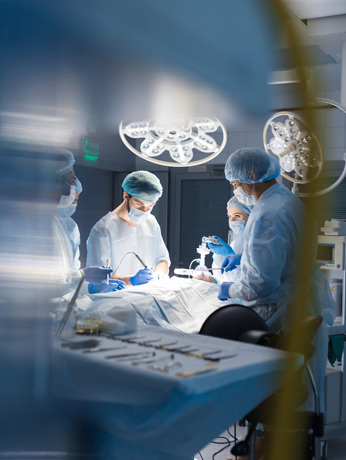Best Sleep Apnea Surgeon in Beverly Hills
As the best sleep apnea surgeon in Beverly Hills, Dr. Shamouelian performs a variety of procedures to treat obstructive sleep apnea. A few types of surgery he is qualified to perform include radiofrequency volumetric tissue reduction, uvulopalatopharyngoplasty (UPPP), maxillomandibular advancement, anterior inferior mandibular osteotomy, genioglossus advancement, midline glossectomy and base of tongue reduction, lingual tonsillectomy, septoplasty and turbinate reduction, hypoglossal nerve stimulator, and hyoid suspension.
Who Qualifies for Sleep Apnea Surgery?

Sleep apnea surgery may be necessary for patients who have not experienced relief from conservative treatment and continue to experience symptoms, such as dry mouth, loud snoring, morning headache, irritability, insomnia, excessive daytime sleepiness, difficulty concentrating, gasping for air during sleep and interrupted breathing during sleep noticed by another person.
Radiofrequency Volumetric Tissue Reduction
During surgery, Dr. Shamouelian uses radiofrequency waves to shrink or remove tissue in the back of the throat. This helps to open up the airway and reduce obstruction.

Uvulopalatopharyngoplasty
This is the most common sleep apnea surgery performed during the past 25 years and involves removing excess tissue from the soft palate and pharynx. The tonsils may also be removed. Once the tissue is removed, Dr. Shamouelian will use sutures to keep the area wide open and prevent collapse. Patients who undergo UPPP typically need to stay overnight in a hospital.
During surgery, the best sleep apnea surgeon in Beverly Hills, Dr. Shamouelian, makes highly precise bone cuts to reposition the upper and lower jaw bones and advance them up to 10mm to 12mm. The jaw bones are stabilized with titanium plates and patients will have their teeth wired shut for several weeks to allow the bones to heal. Patients will need to stay in the hospital for several nights after surgery to ensure full recovery.
This procedure involves dividing the chin bone into two parts to allow the tongue to move forward and open up the airway. Patients will typically have to undergo another procedure in conjunction with an anterior inferior mandibular osteotomy to increase effectiveness.
Dr. Shamouelian, the best sleep apnea surgeon in Beverly Hills, performs this procedure by making a rectangular cut in the jaw bone where the genioglossus muscle is attached. He then moves the piece of bone forward and fixes it into place with a small titanium plate. The procedure is highly effective and can provide patients with significant relief.
This type of surgery involves removing a portion of the back of the tongue to enlarge the airway and alleviate obstruction.
During lingual tonsillectomy, the best sinus surgeon in Beverly Hills removes the tonsils and tonsillar tissue to open up the lower part of the throat and alleviate symptoms of sleep apnea.
Patients may need to undergo a septoplasty if their symptoms are caused by a deviated nasal septum. A turbinate reduction may be necessary if patients have enlarged turbinates blocking airflow.
During this type of sleep apnea surgery, the best sinus surgeon in Beverly Hills, Dr. Shamouelian, attaches an electrode to the hypoglossal nerve that works to stimulate the tongue muscles during sleep to improve breathing.
A hyoid suspension involves moving the hyoid bone and nearby neck muscles closer to the front of the neck to help open up the airway.
